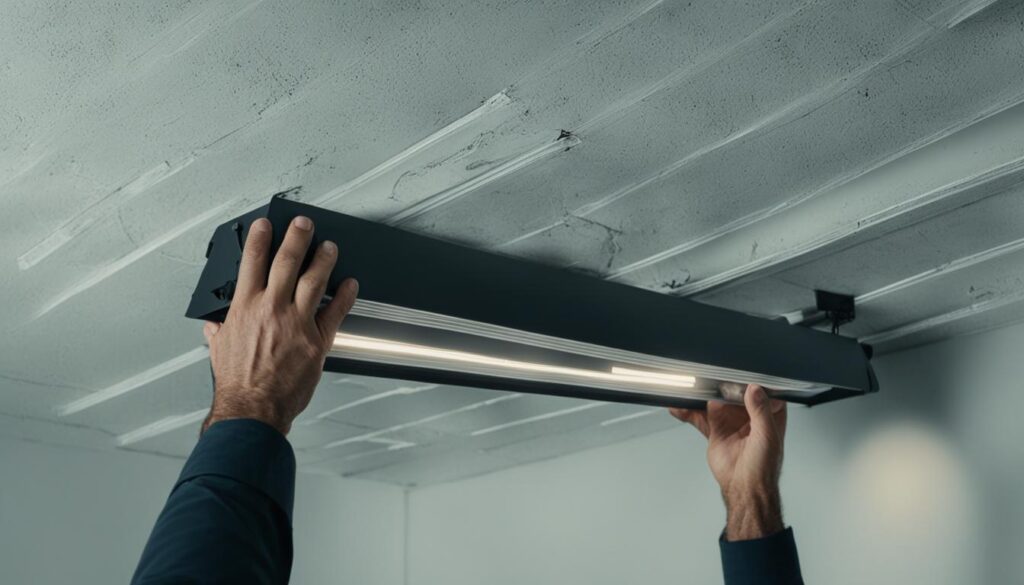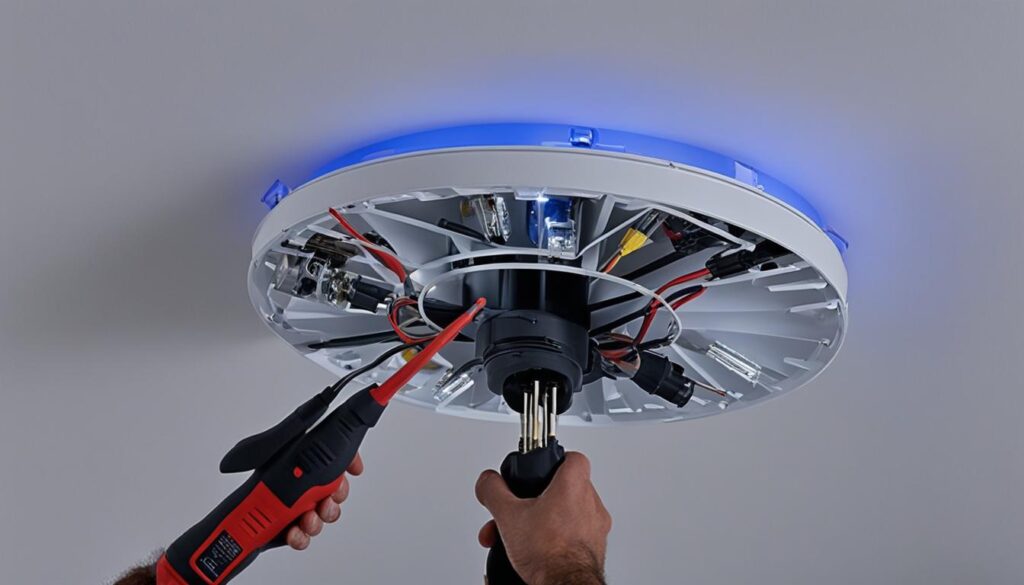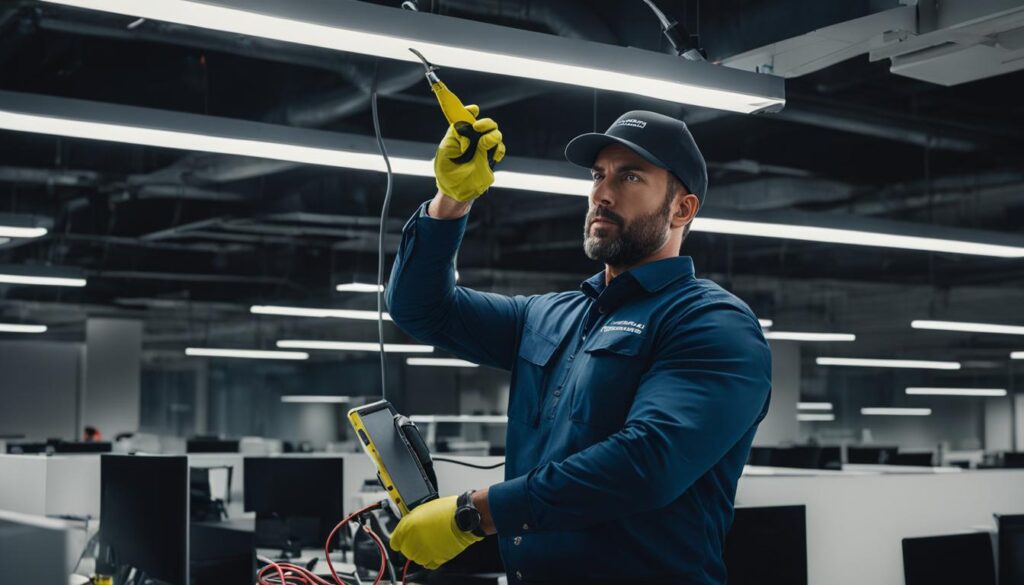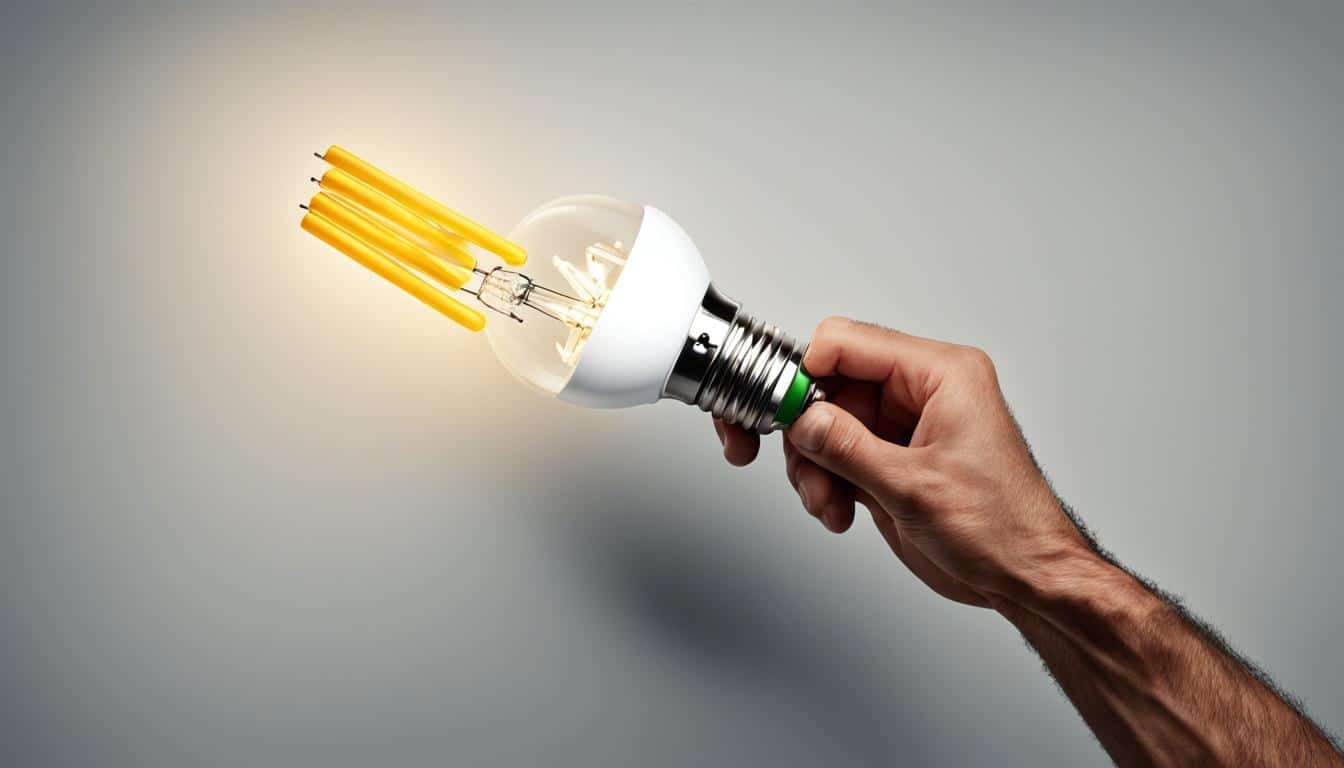In the constantly evolving landscape of lighting technology, our understanding and handling of modern lighting solutions have become more sophisticated. Among the advancements, integrated LED fixtures stand out as a sustainable choice for both commercial and residential spaces, attributing their popularity to their energy efficiency and the longevity they offer. Despite these benefits, one pertinent question surfaces—how does one go about replacing integrated LED light bulbs? In this guide, we’ll delve into the methods of integrated LED bulb replacement, guiding you through the intricacies of ensuring that your space continues to benefit from the innovation of LED lighting.
Whether you’re faced with an LED that has reached the end of its lifespan or you’re simply looking to update your space with the latest lighting technology, this guide will provide you with the essential how-tos and considerations for a smooth transition. We’ll explore the scope of replacing integrated LED light bulbs and the factors that come into play to maintain the functionality and aesthetic of your lighting fixtures.
Key Takeaways
- Grasp the fundamental concepts behind integrated LED fixtures and their role in modern lighting solutions.
- Understand the conditions and potential for replacing bulbs in integrated LED fixtures.
- Consider the technical considerations, such as compatibility and power requirements, when replacing an integrated LED.
- Recognize the benefits LED lighting provides in terms of energy efficiency and operational cost savings.
- Discover the best practices for a secure and functional integrated LED bulb replacement.
Understanding Integrated LED Light Bulb Technology
As lighting solutions become more innovative, we see integrated LED fixtures changing the way we illuminate our spaces. These fixtures are not only energy-efficient but also highly durable, reflecting significant technological progress from traditional lighting methods.
The Advancements in Integrated LED Fixtures
Integrated LEDs stand at the forefront of lighting technology, pushing the boundaries with advancements that blend efficiency with sleek designs. In line with this, they encapsulate various LED technologies such as SMD and COB, enhancing their utility across diverse applications.
Differentiating Between Integrated and Traditional LED Bulbs
Drawing a contrast between integrated LED fixtures and traditional LED bulbs, one can notice the former’s characteristic of being an intrinsic part of their fixture. Unlike traditional LEDs that fit into typical sockets, integrated variants streamline overall fixture design.
The Durability and Lifespan of Integrated LED Bulbs
The durability of integrated LED light bulbs is a testament to their superior construction, often translating into an impressive lifespan of integrated LED that can stretch from 15,000 to a staggering 50,000 hours of service. Such longevity implies fewer replacements and prolonged efficiency.
| Feature | Integrated LED | Traditional LED Bulb |
|---|---|---|
| Fixture Compatibility | Built-in | Socket Fit |
| Lifespan | 15,000 – 50,000 hours | Varies |
| Design | Compact, Unified | Standardized |
| Technology Employed | SMD, COB LEDs | Various LED Types |
| Durability | High | Dependent on bulb quality |
| Energy Efficiency | Optimized | Dependent on model |
As we dive deeper into the realm of advanced lighting, our understanding of integrated LED technology is crucial in harnessing its full potential, from its remarkable durability to its extensive lifespan.
Benefits of LED Lighting: Energy Efficiency and Longevity
At the forefront of modern lighting solutions, LED technology stands out for its exceptional energy efficiency and enduring lifespan. These attributes significantly tip the scale in favor of LED lighting when making the prudent switch from conventional lighting options. By delving into the specifics, we can fully appreciate how LED lighting is revolutionizing the way we illuminate our spaces.

Comparing LED Energy Consumption to Traditional Bulbs
LED bulbs have redefined the standards of energy consumption in lighting. These innovative bulbs require substantially less power to operate, with savings of up to 80% compared to their traditional incandescent counterparts. This staggering difference not only represents a leap in energy efficiency of LED lighting but also underscores the importance of transitioning to more economical and sustainable practices.
Calculating the Cost Savings of Switching to LEDs
Contemplating the switch to LEDs often includes an evaluation of initial costs versus long-term savings. Adopting LED bulbs might seem costly upfront, but this investment pays dividends in energy and maintenance savings. By using our homes and businesses as case studies, we can calculate the cost savings with LED bulbs over an extended period, often finding that the lowered electricity bills swiftly offset the initial investment.
Understanding the Long-Term Benefits of LED Lights
Quantifying the long-term benefits of LED lights involves more than just reduced energy bills. The extended lifespan of LEDs means less frequent replacements, thus saving on both the cost of new bulbs and labor for installations. Moreover, their reduced heat output translates to a cooler environment, potentially lowering air conditioning expenses. In terms of environmental impact, LEDs contribute to a significant reduction in carbon footprint, further reinforcing their role in our journey towards a sustainable future.
Can an Integrated LED Light Bulb Be Replaced?
When it comes to modern lighting solutions, we often encounter inquiries about whether integrated LED light bulbs can be replaced. The industry’s resounding answer is yes, although the replacement process deviates from the usual bulb swapping in traditional fixtures. Understanding how to replace an integrated LED light bulb is crucial for maintaining the fixture’s efficiency and performance after the upgrade or repair.
Integrated LEDs are designed differently, incorporating the light source directly into the lighting fixture. While this integration is beneficial for numerous reasons, such as design and energy efficiency, it does introduce complexity into the replacement procedure, necessitating a comprehensive approach that encompasses checking compatibility, power requirements, and ease of replacement. For some integrated LED light fixtures, the process may even demand professional assistance, particularly if intricate disassembly or soldering is involved.
To elucidate the intricacies of replacing integrated LED light bulbs, we’ve compiled a detailed table to assist you in navigating the process:
| Step | Description | Importance |
|---|---|---|
| Power Off | Ensure all power sources to the fixture are disconnected. | Critical for safety to prevent electrical hazards. |
| Assessment | Examine the fixture for accessible screws or fasteners. | Enables proper disassembly without damaging the fixture. |
| Removal | Carefully remove the existing integrated LED module. | Prevents damage to the fixture and the replacement LED. |
| Compatibility Check | Match the new LED bulb’s power requirements with the fixture. | Ensures the new LED module will function correctly. |
| Installation | Secure the new integrated LED bulb in place. | Affects the longevity and effectiveness of the replacement. |
| Testing | Reconnect power and test the new LED for functionality. | Confirms the success of the replacement procedure. |
In some scenarios, manufacturers provide guidance and LED modules that are intended explicitly for their fixtures, simplifying the
how to replace an integrated LED light bulb
puzzle. Nevertheless, if you’re at all uncertain or if the replacement task involves elaborate disassembly, we always suggest consulting with or hiring a professional to ensure the job is done safely and correctly.
Ultimately, the primary objective is not just to replace an LED component but to maintain or even enhance the original design integrity and performance of the lighting system. With thoroughness and attention to detail, we can overcome the challenges presented by integrated LED light bulbs and continue to enjoy their benefits for many more years to come.
Exploring LED Tubes as a Replacement Option
As we delve into the world of efficient lighting, LED tubes stand out as a stellar substitute for conventional fluorescent tubes. Their compelling benefits and versatility have made them a popular choice for those seeking improvements in lighting and energy consumption. Today, we’re going to unravel the intricacies of replacing integrated LED light bulbs in fixtures with LED tubes and what this means for the color temperature of LED tubes, as well as their various sizes and safety standards.

Decoding Color Temperature and Tube Sizes
Color temperature plays a critical role in setting the ambiance of any given space. Whether it’s the inviting warmth of a coffee shop or the clear, bright ambiance of an office, the color temperature of LED tubes is pivotal. Measured in Kelvin, this evident spectrum ranges from cozy warm tints of around 2400K to the crisp daylight equivalence of 6500K or higher. This diversity not only impacts visual comfort but also functionality within a space.
The specific size of LED tubes is equally important. They are identified by a ‘T’ designation, followed by a numeric value indicating the diameter of the bulb in eighths of an inch. Common sizes like T8 and T12 have their unique applications, with T8 often being the more energy-efficient choice for newly designed fixtures or retrofitting opportunities.
Assessing the Quality and Safety Standards of LED Tubes
When we transition to LED tubes as a replacement, we cannot overlook the importance of adherence to quality and safety standards. These ensure that the products not only perform reliably but also integrate safely into our existing fixtures. A vigorous evaluation of an LED tube’s certifications and its manufacturer’s reputation will guide us towards products that promise durability and peace of mind. It is this meticulous attention to detail that empowers us to make sustainable and enlightened choices in our journey to optimize our illumination solutions.
Selecting the Right Integrated LED Bulb Replacement
When it’s time to upgrade or replace lighting in your home or business, knowing how to go about selecting the right integrated LED bulb replacement is paramount to ensure compatibility and efficiency. It’s not simply about purchasing bulbs; it involves a thoughtful analysis of existing fixtures, understanding the technology differences, and navigating the installation intricacies to achieve optimal lighting performance.
Compatibility and Installation Methods for Various LED Types
We know that the broad spectrum of LED technology can be daunting. There are myriad types and models, each with its own set of requirements and benefits. Whether you’re dealing with pin-based lamps or direct wire options, you must understand the specific compatibility and installation for LEDs that you’re considering. It involves checking voltage, base type, and the physical dimensions to match your current setup or ascertain whether modifications are necessary.
Understanding the Significance of Tube Type: T8 vs. T12
The distinction between T8 and T12 LED tube types is a critical consideration when selecting a new LED tube. If you currently have T12 fixtures, it’s essential to recognize that they are generally geared towards older magnetic ballasts, whereas T8 tubes are tailored for modern electronic ballasts, thereby affecting the compatibility with your current system.
Don’t know whether you have T8 or T12? Check the existing tube’s diameter – T8 tubes are 1 inch in diameter while T12 tubes are 1.5 inches. Additionally, energy consumption is a noteworthy talking point: T8 LEDs are often more energy-efficient than T12s, promising cost savings and better performance.
We understand the complexities involved in selecting LED replacements and commit to providing all the necessary information to make an informed decision, emphasizing factors like color rendering index, light output, and energy consumption. Our aim is to facilitate a seamless transition to LED technology that enhances your space both functionally and aesthetically.
Replacing Integrated LED Light Bulb in Fixtures
Delving into the world of DIY integrated LED light bulb replacement, we recognize the varied landscape of fixtures and bulbs. This section will guide you through the steps necessary to upgrade and maintain your home or workplace lighting with ease and confidence. Whether you’re tackling a replacing integrated LED bulb in recessed lighting project or considering the utility of smart LED retrofit kits, we’ll provide the insights you need to succeed.
DIY Steps to Replace Integrated LED Bulbs in Common Fixtures
For those who relish the satisfaction of fixing things themselves, here’s how to navigate the replacement process:
- Switch off the power source to ensure safety.
- Carefully disassemble the fixture to access the LED components.
- Remove the existing LED module, taking note of the connections.
- Position and secure the new LED bulb, ensuring all connections mirror the original setup.
- Reassemble the fixture and restore power to test the new bulb.
Replacing Integrated LED Bulb in Recessed Lighting
Recessed lighting often requires specialized steps due to its design. Below is a methodical approach:
- Ensure the power is off and prepare your tools.
- Detach the lighting trim and remove the faceplate if applicable.
- Unscrew or unclip the old LED module from the housing.
- Compare the new LED bulb with the old to confirm compatibility.
- Connect and secure the new bulb into place.
- Replace the faceplate and trim, then switch the power back on for a functionality check.

Orienting Yourself with Conversion Kits and Smart LED Options
For the tech-savvy, smart LED retrofit kits present an avenue to infuse intelligence into your lighting solutions. These kits are designed to interface seamlessly with your existing recessed fixtures:
| Feature | Benefit |
|---|---|
| Voice Activation | Control lighting with simple voice commands. |
| Dimming Capability | Adjust brightness to your preferred level without needing a dimmer switch. |
| Variable Color Temperatures | Switch between warm and cool lighting to create the perfect mood for any occasion. |
| Energy Efficiency | Lower your power consumption and enjoy a reduced carbon footprint. |
Equipped with these technology upgrades, your living or work space can bask in the optimized ambiance, efficiency, and control that smart lighting solutions provide.
Professional vs. DIY Integrated LED Bulb Replacement
When it comes to upgrading or repairing your lighting system, the decision to opt for a professional integrated LED replacement or take on the task yourself is worth considering. There are factors like lighting complexity and personal expertise that influence this choice, and we’re here to shed light on the best route forward for your situation.
When to Call a Professional for LED Light Replacement
It’s prudent to consider professional help when dealing with complex lighting fixtures or when you want to ensure warranty compliance. Professionals come equipped with the right tools and experience necessary to handle intricate designs and technical setups, reducing the risk of potential damage or voiding warranties. Moreover, for commercial settings where lighting systems are extensive and high-performing, a professional service guarantees that business operations are minimally disrupted.
Tools and Safety Precautions for DIY Integrated LED Replacement
For the avid DIYer, replacing an integrated LED light bulb can be a gratifying endeavor, provided you follow best practices for replacing integrated LED light bulbs and adhere to necessary safety precautions in LED replacement. It’s essential to turn off the power supply and strategically utilize non-conductive tools to mitigate the risk of electrical shock.
Let’s delve into the essential tools you might need and relevant safety gear to ensure a successful DIY replacement:
| Tool/Equipment | Function | Safety Gear | Purpose |
|---|---|---|---|
| Screwdrivers | To disassemble lighting fixtures | Insulated Gloves | Protection from electric shock |
| Soldering Iron | For affixing LED components | Safety Glasses | Prevent eye injuries from soldering splatter |
| Wire Strippers | For preparing electrical wires | Non-Conductive Shoes | Minimize electrocution risks |
| Voltage Tester | To ensure no live wires during work | Hard Hat | Providing head protection |
| LED Replacement Kit | For accurate replacement of LED bulbs | Work Apron | To keep tools handy and protect clothing |
By arming yourself with the necessary tools and safeguarding measures, you’ll be able to tackle any lighting project confidently. Remember, safety is paramount when handling electrical installations. Even as a knowledgeable DIY enthusiast, if a project seems beyond your scope, there’s no shame in calling a professional—ensuring the longevity and efficiency of your LED lighting is the ultimate goal.

Best Practices for Replacing Integrated LED Light Bulbs
As we delve into the realm of modern lighting, we understand the critical importance of adhering to best practices when replacing integrated LED light bulbs. These practices are not mere suggestions but rather essential steps to ensure safety, performance, and longevity of your LED installations.

Ensuring Correct Polarity and Secure Installation
The initial phase of our replacement process revolves around ensuring correct polarity in LED installation. This pivotal step prevents potential malfunction or irreversible damage to your new lighting component. Ensuring the correct polarity is akin to setting a solid foundation for the secure installation of the integrated LED light bulb.
- Identify the positive and negative leads on both the LED bulb and fixture.
- Align and connect the leads accordingly to match the correct polarity.
- Secure the installation avoiding any loose connections that could lead to instability.
Testing and Troubleshooting Post-Installation
Our meticulous approach does not end upon securing the LED bulb in its rightful place. Testing LED bulb after replacement is a testament to our commitment to quality and functionality. Through a series of operational tests, we confirm the effectiveness of our installation, ensuring the lighting solution we’ve implemented meets our high standards.
- Perform a visual inspection prior to restoring power to check for any apparent issues.
- Restore power to the fixture and observe the initial response of the LED bulb.
- Conduct a functionality test, examining the LED’s performance in various scenarios.
In the event of inconsistencies, our troubleshooting process begins by revisiting the installation steps to identify and rectify any inaccuracies. Should the issue persist, we consider expert analysis to solve any complex challenges that may arise.
Conclusion
As we have explored throughout this guide, replacing integrated LED light bulbs, while challenging, is an attainable task for those equipped with the right knowledge and tools. Our journey through the concluding LED replacement techniques has unveiled that, whether opting for a DIY approach or enlisting professional aid, attention to detail and a thorough understanding of the fixtures at hand play pivotal roles in ensuring a successful update to your lighting system.
Summarizing Integrated LED Replacement Techniques
We’ve emphasized the importance of maintaining LED lighting efficiency, a significant aspect that underscores the necessity for proper replacement methods. By upholding the standards of compatibility, installation best practices, and safety measures, we ensure that our efforts result in lasting performance and sustainability of the integrated LED fixtures.
The Future of Integrated LED Lighting and Upkeep
Looking ahead, the future of integrated LED lighting shines brightly, with ongoing advancements that promise even greater ease in maintenance and energy efficiency. Our commitment to equipping our readers with the know-how for keeping pace with these innovations enables wider adoption of eco-friendly lighting solutions. We will continue to observe the evolution of this technology, prepared to embrace new advancements that aid in advancing our shared goal of a sustainable and energy-efficient world.
FAQ
Can an integrated LED light bulb be replaced?
Yes, an integrated LED light bulb can be replaced, though the process is different from changing a traditional bulb. It typically requires more technical knowledge and may involve disassembling the fixture, ensuring compatibility, and possibly soldering.
What are the advancements in integrated LED fixtures?
Integrated LED fixtures have seen advancements in terms of energy efficiency, compact design, and longevity, with some LEDs boasting lifespans of 15,000 to 50,000 hours. The integration of advanced LED technologies like SMD and COB LEDs also enhances performance and durability.
How do integrated LED bulbs differ from traditional LED bulbs?
Integrated LED bulbs are built directly into the fixtures, which makes them part of the device itself, as opposed to traditional LED bulbs that fit into standard sockets and can be easily replaced.
What are the durability and lifespan of integrated LED bulbs?
The durability of integrated LED bulbs is reflected in their extended lifespan, often between 15,000 to 50,000 hours, which means they can last for years without needing a replacement.
How does LED energy consumption compare to traditional bulbs?
LEDs consume significantly less energy than traditional incandescent or fluorescent bulbs while providing comparable or superior brightness, leading to lower electrical costs and environmental impact.
What are the cost savings when switching to LEDs?
Switching to LEDs can result in considerable cost savings due to their lower energy consumption, reduced maintenance costs owing to their longer lifespan, and fewer bulb replacements needed over time.
What are the long-term benefits of LED lights?
The long-term benefits of LED lights include higher energy efficiency, longer operational life span, reduced maintenance costs, and less environmental impact than traditional lighting solutions.
How do you replace an integrated LED light bulb?
Replacing an integrated LED light bulb involves turning off the power supply, disassembling the light fixture to access the LED, removing the old LED module, and correctly installing a new unit that is compatible with the fixture.
What should I consider when replacing integrated LED bulbs in fixtures?
When replacing integrated LED bulbs in fixtures, consider factors such as compatibility with the fixture, power requirements, the technical difficulty of the replacement process, available tools, and adherence to safety protocols.
Are LED tubes a good replacement option for traditional tubes?
LED tubes are an efficient and viable replacement for traditional fluorescent tubes. They offer improvements in energy efficiency, require less maintenance, and come in various sizes and color temperatures to match lighting needs.
How do I ensure the integrated LED bulb I select is the right replacement?
To ensure the integrated LED bulb is the right replacement, check for compatibility with the existing fixture, confirm that the power requirements match, and consider factors such as the LED’s type, color rendering index, light output, and energy consumption.
What are the differences between T8 and T12 LED tube types?
T8 LED tubes are commonly used with modern electronic ballasts and are more energy-efficient, while T12 LED tubes are compatible with older magnetic ballast technology and are being phased out in favor of the newer T8 technology.
Can DIY enthusiasts replace their integrated LED bulbs themselves?
DIY enthusiasts can replace their integrated LED bulbs themselves if they have the necessary technical skills and tools. They should follow safety precautions, such as turning off the power supply and properly handling electrical components.
When should I hire a professional to replace integrated LED light bulbs?
Hiring a professional is recommended when the light fixture is complex, requires specialized knowledge for disassembly or reassembly, or when warranty considerations are in play. Professionals ensure a safe replacement and can often guarantee the quality of their work.
What are the best practices for ensuring correct polarity and secure installation in LED replacement?
Best practices for ensuring correct polarity and secure installation include double-checking the positive and negative connections of the LED module, following manufacturer’s instructions carefully, and securing all connections properly to avoid any electrical faults.
How do I test my LED bulb after replacement?
After replacing an LED bulb, test it by turning the power back on and observing if it lights up correctly. Check for any flickering or inconsistent performance, which may indicate improper installation or a faulty bulb.

